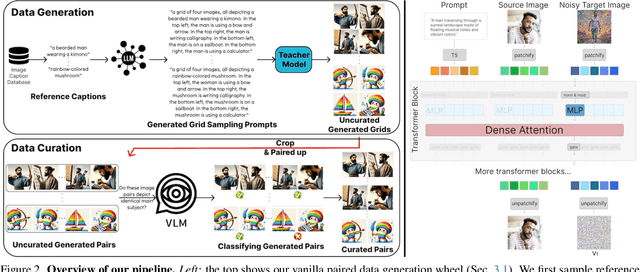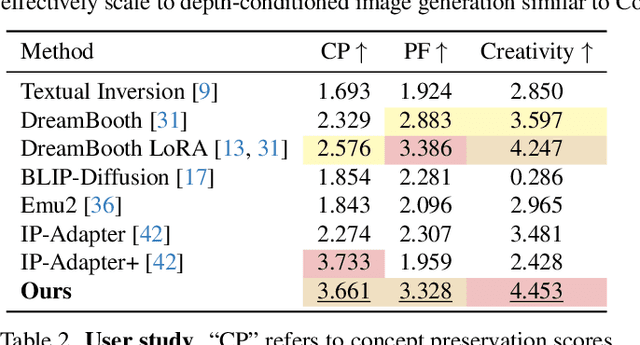Yunzhi Zhang
Digital Twin Catalog: A Large-Scale Photorealistic 3D Object Digital Twin Dataset
Apr 11, 2025Abstract:We introduce Digital Twin Catalog (DTC), a new large-scale photorealistic 3D object digital twin dataset. A digital twin of a 3D object is a highly detailed, virtually indistinguishable representation of a physical object, accurately capturing its shape, appearance, physical properties, and other attributes. Recent advances in neural-based 3D reconstruction and inverse rendering have significantly improved the quality of 3D object reconstruction. Despite these advancements, there remains a lack of a large-scale, digital twin quality real-world dataset and benchmark that can quantitatively assess and compare the performance of different reconstruction methods, as well as improve reconstruction quality through training or fine-tuning. Moreover, to democratize 3D digital twin creation, it is essential to integrate creation techniques with next-generation egocentric computing platforms, such as AR glasses. Currently, there is no dataset available to evaluate 3D object reconstruction using egocentric captured images. To address these gaps, the DTC dataset features 2,000 scanned digital twin-quality 3D objects, along with image sequences captured under different lighting conditions using DSLR cameras and egocentric AR glasses. This dataset establishes the first comprehensive real-world evaluation benchmark for 3D digital twin creation tasks, offering a robust foundation for comparing and improving existing reconstruction methods. The DTC dataset is already released at https://www.projectaria.com/datasets/dtc/ and we will also make the baseline evaluations open-source.
Birth and Death of a Rose
Dec 06, 2024



Abstract:We study the problem of generating temporal object intrinsics -- temporally evolving sequences of object geometry, reflectance, and texture, such as a blooming rose -- from pre-trained 2D foundation models. Unlike conventional 3D modeling and animation techniques that require extensive manual effort and expertise, we introduce a method that generates such assets with signals distilled from pre-trained 2D diffusion models. To ensure the temporal consistency of object intrinsics, we propose Neural Templates for temporal-state-guided distillation, derived automatically from image features from self-supervised learning. Our method can generate high-quality temporal object intrinsics for several natural phenomena and enable the sampling and controllable rendering of these dynamic objects from any viewpoint, under any environmental lighting conditions, at any time of their lifespan. Project website: https://chen-geng.com/rose4d
Diffusion Self-Distillation for Zero-Shot Customized Image Generation
Nov 27, 2024



Abstract:Text-to-image diffusion models produce impressive results but are frustrating tools for artists who desire fine-grained control. For example, a common use case is to create images of a specific instance in novel contexts, i.e., "identity-preserving generation". This setting, along with many other tasks (e.g., relighting), is a natural fit for image+text-conditional generative models. However, there is insufficient high-quality paired data to train such a model directly. We propose Diffusion Self-Distillation, a method for using a pre-trained text-to-image model to generate its own dataset for text-conditioned image-to-image tasks. We first leverage a text-to-image diffusion model's in-context generation ability to create grids of images and curate a large paired dataset with the help of a Visual-Language Model. We then fine-tune the text-to-image model into a text+image-to-image model using the curated paired dataset. We demonstrate that Diffusion Self-Distillation outperforms existing zero-shot methods and is competitive with per-instance tuning techniques on a wide range of identity-preservation generation tasks, without requiring test-time optimization.
The Scene Language: Representing Scenes with Programs, Words, and Embeddings
Oct 22, 2024Abstract:We introduce the Scene Language, a visual scene representation that concisely and precisely describes the structure, semantics, and identity of visual scenes. It represents a scene with three key components: a program that specifies the hierarchical and relational structure of entities in the scene, words in natural language that summarize the semantic class of each entity, and embeddings that capture the visual identity of each entity. This representation can be inferred from pre-trained language models via a training-free inference technique, given text or image inputs. The resulting scene can be rendered into images using traditional, neural, or hybrid graphics renderers. Together, this forms a robust, automated system for high-quality 3D and 4D scene generation. Compared with existing representations like scene graphs, our proposed Scene Language generates complex scenes with higher fidelity, while explicitly modeling the scene structures to enable precise control and editing.
3D Congealing: 3D-Aware Image Alignment in the Wild
Apr 02, 2024



Abstract:We propose 3D Congealing, a novel problem of 3D-aware alignment for 2D images capturing semantically similar objects. Given a collection of unlabeled Internet images, our goal is to associate the shared semantic parts from the inputs and aggregate the knowledge from 2D images to a shared 3D canonical space. We introduce a general framework that tackles the task without assuming shape templates, poses, or any camera parameters. At its core is a canonical 3D representation that encapsulates geometric and semantic information. The framework optimizes for the canonical representation together with the pose for each input image, and a per-image coordinate map that warps 2D pixel coordinates to the 3D canonical frame to account for the shape matching. The optimization procedure fuses prior knowledge from a pre-trained image generative model and semantic information from input images. The former provides strong knowledge guidance for this under-constraint task, while the latter provides the necessary information to mitigate the training data bias from the pre-trained model. Our framework can be used for various tasks such as correspondence matching, pose estimation, and image editing, achieving strong results on real-world image datasets under challenging illumination conditions and on in-the-wild online image collections.
SHINOBI: Shape and Illumination using Neural Object Decomposition via BRDF Optimization In-the-wild
Jan 18, 2024Abstract:We present SHINOBI, an end-to-end framework for the reconstruction of shape, material, and illumination from object images captured with varying lighting, pose, and background. Inverse rendering of an object based on unconstrained image collections is a long-standing challenge in computer vision and graphics and requires a joint optimization over shape, radiance, and pose. We show that an implicit shape representation based on a multi-resolution hash encoding enables faster and robust shape reconstruction with joint camera alignment optimization that outperforms prior work. Further, to enable the editing of illumination and object reflectance (i.e. material) we jointly optimize BRDF and illumination together with the object's shape. Our method is class-agnostic and works on in-the-wild image collections of objects to produce relightable 3D assets for several use cases such as AR/VR, movies, games, etc. Project page: https://shinobi.aengelhardt.com Video: https://www.youtube.com/watch?v=iFENQ6AcYd8&feature=youtu.be
Learning the 3D Fauna of the Web
Jan 04, 2024Abstract:Learning 3D models of all animals on the Earth requires massively scaling up existing solutions. With this ultimate goal in mind, we develop 3D-Fauna, an approach that learns a pan-category deformable 3D animal model for more than 100 animal species jointly. One crucial bottleneck of modeling animals is the limited availability of training data, which we overcome by simply learning from 2D Internet images. We show that prior category-specific attempts fail to generalize to rare species with limited training images. We address this challenge by introducing the Semantic Bank of Skinned Models (SBSM), which automatically discovers a small set of base animal shapes by combining geometric inductive priors with semantic knowledge implicitly captured by an off-the-shelf self-supervised feature extractor. To train such a model, we also contribute a new large-scale dataset of diverse animal species. At inference time, given a single image of any quadruped animal, our model reconstructs an articulated 3D mesh in a feed-forward fashion within seconds.
Ponymation: Learning 3D Animal Motions from Unlabeled Online Videos
Dec 21, 2023Abstract:We introduce Ponymation, a new method for learning a generative model of articulated 3D animal motions from raw, unlabeled online videos. Unlike existing approaches for motion synthesis, our model does not require any pose annotations or parametric shape models for training, and is learned purely from a collection of raw video clips obtained from the Internet. We build upon a recent work, MagicPony, which learns articulated 3D animal shapes purely from single image collections, and extend it on two fronts. First, instead of training on static images, we augment the framework with a video training pipeline that incorporates temporal regularizations, achieving more accurate and temporally consistent reconstructions. Second, we learn a generative model of the underlying articulated 3D motion sequences via a spatio-temporal transformer VAE, simply using 2D reconstruction losses without relying on any explicit pose annotations. At inference time, given a single 2D image of a new animal instance, our model reconstructs an articulated, textured 3D mesh, and generates plausible 3D animations by sampling from the learned motion latent space.
Language-Informed Visual Concept Learning
Dec 06, 2023Abstract:Our understanding of the visual world is centered around various concept axes, characterizing different aspects of visual entities. While different concept axes can be easily specified by language, e.g. color, the exact visual nuances along each axis often exceed the limitations of linguistic articulations, e.g. a particular style of painting. In this work, our goal is to learn a language-informed visual concept representation, by simply distilling large pre-trained vision-language models. Specifically, we train a set of concept encoders to encode the information pertinent to a set of language-informed concept axes, with an objective of reproducing the input image through a pre-trained Text-to-Image (T2I) model. To encourage better disentanglement of different concept encoders, we anchor the concept embeddings to a set of text embeddings obtained from a pre-trained Visual Question Answering (VQA) model. At inference time, the model extracts concept embeddings along various axes from new test images, which can be remixed to generate images with novel compositions of visual concepts. With a lightweight test-time finetuning procedure, it can also generalize to novel concepts unseen at training.
Holistic Evaluation of Text-To-Image Models
Nov 07, 2023



Abstract:The stunning qualitative improvement of recent text-to-image models has led to their widespread attention and adoption. However, we lack a comprehensive quantitative understanding of their capabilities and risks. To fill this gap, we introduce a new benchmark, Holistic Evaluation of Text-to-Image Models (HEIM). Whereas previous evaluations focus mostly on text-image alignment and image quality, we identify 12 aspects, including text-image alignment, image quality, aesthetics, originality, reasoning, knowledge, bias, toxicity, fairness, robustness, multilinguality, and efficiency. We curate 62 scenarios encompassing these aspects and evaluate 26 state-of-the-art text-to-image models on this benchmark. Our results reveal that no single model excels in all aspects, with different models demonstrating different strengths. We release the generated images and human evaluation results for full transparency at https://crfm.stanford.edu/heim/v1.1.0 and the code at https://github.com/stanford-crfm/helm, which is integrated with the HELM codebase.
 Add to Chrome
Add to Chrome Add to Firefox
Add to Firefox Add to Edge
Add to Edge